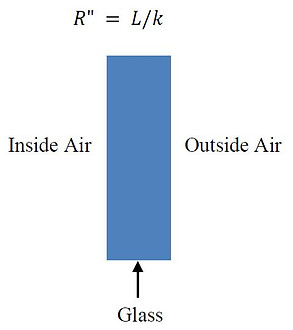
Workshop #10 - Window Conduction Introduction
Windows are a major source of heat loss in buildings. Many older windows and storm doors use a single pane of glass, typically 1/8 inch thick. This is still the case in the older engineering buildings on our campus. The thermal resistance of the window should be measurable from the heat flux q" and temperature difference across the glass ΔT. At steady-state conditions the conduction heat flux is
where k is the thermal conductivity of the glass and L is the thickness. The corresponding thermal resistance is
Note: It is very difficult to accurately measure the surface temperature of materials when heat transfer is occurring to or from the surface. Thermal contact resistance is relatively large, especially for the usual bead thermocouples. Conversely, the heat flux is typically measured over a much larger area and at steady-state conditions, what goes in must come out. Consequently, contrary to popular opinion it is normally much easier to accurately measure heat flux on a surface than temperature.
Mount the heat flux sensor on the inside of the window with the thermocouple on the side next to the glass. Measure the heat flux and temperature at steady-state. Then repeat for the outside of the window. Use the second thermocouple to record the air temperature at the same time. Record the steady-state values below and sketch the temperature distribution on the figure. Label the direction of the heat flux.
1. Why do the heat flux values have opposite sign between the inside and outside of the window?
2. Apply an energy balance around the window. What does it say about the relation between your measured heat flux values?
3. What reasons would cause the magnitude of heat flux measured values to not be equal?
4. Neglect radiation and solve the conduction equation for the temperature difference across the glass for the average heat flux. The thermal conductivity for glass is typically about k = 1.0 W/m-K and the thickness is about L = 3 mm.
Calculated ΔT = Measured ΔT =
5. Why are these values so different?


Workshop #10 - Window Conduction Results
